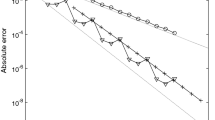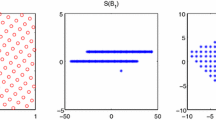Abstract
In recent years a great amount of work has been done searching for what are called good lattice rules. Lattice rules are used for the numerical integration of smooth functions over the unit s-dimensional cube Is. The integrand has to be periodic with period 1 with respect to each coordinate separately. So, it is important to look for good methods of periodizing functions. In the past, there were already proposed a few methods. We show that IMT-transformations are good methods of periodizing certain families of functions when lattice rules are used.
Access this chapter
Tax calculation will be finalised at checkout
Purchases are for personal use only
Preview
Unable to display preview. Download preview PDF.
Similar content being viewed by others
References
NAG FORTRAN LIBRARY MANUAL, MARK 13, 1989. The Numerical Algorithm Group, Oxford, United Kingdom.
E. De Doncker and R. Piessens. Algorithm 32 — automatic computation of integrals with singular integrand, over a finite or an infinite range. Computing, 17: 265–279, 1976.
A.C. Genz. Testing multidimensional integration routines. In Proceedings of INRIA Conference on Software Tools, Methods and Languages. North Holland, Amsterdam, 1984.
A.C. Hearn. REDUCE User’s Guide, Version 3.3. The RAND Corporation, 1988.
L.K. Hua and Y. Wang. Applications of Number Theory to Numerical Analysis. Springer-Verlag, 1981.
M. Iri, S. Moriguti, and Y. Takasawa. On a certain quadrature formula. Kokyuroku, Res. Inst. Sci. Kyoto Univ., 91: 82–118, 1970. (in Japanese).
N.M. Korobov. Number-Theoretic Methods of Approximate Analysis. Fitzmatgiz, 1963. (Russian).
J.N. Lyness. Performance profiles and software evaluation. Technical Memorandum 343, Argonne National Laboratory Applied Mathematics Division, 1979.
J.N. Lyness and J.J. Kaganove. Comments on the nature of automatic quadrature routines. ACM Trans. Math. Software, 2: 65–81, 1976.
J.N. Lyness and J.J. Kaganove. A technique for comparing automatic quadrature routines. Computer J., 20: 170–177, 1977.
M. Mori. An IMT-type double exponential formula for numerical integration. Publ. Res. Inst. Math. Sci. Kyoto Univ., 14: 713–729, 1978.
K. Murota and M. Iri. Parameter tuning and repeated application of the imt-type transformation in numerical quadrature. Numer. Math., 38: 347–363, 1982.
H. Niederreiter. Quasi-Monte Carlo methods and pseudo-random numbers. Bulletin of the American Mathematical Society, 84: 957–1041, 1978.
T.W. Sag and G. Szekeres. Numerical evaluation of high-dimensional integrals. Math. Comp., 18: 245–253, 1964.
I.H. Sloan. Lattice methods for multiple integration. J. Comput. Appl. Math., 12 & 13: 131–143, 1985.
I.H. Sloan and P.J. Kachoyan. Lattice mathods for multiple integration: theory, error analysis and examples. SIAM J. Numer. Anal., 14: 117–128, 1987.
I.H. Sloan and T.R. Osborn. Multiple integration over bounded and unbounded regions. J. Comput. Appl. Math., 17: 181–196, 1987.
M. Sugihara. Method of good matrices for multi-dimensional numerical integrations — An extension of the method of good lattice points. J. Comput. Appl. Math., 17: 197–213, 1987.
H. Takahasi and M. Mori. Error estimation in the numerical integration of analytic functions. Rep. Comput. Centre, Univ. Tokyo, 3: 41–108, 1970.
H. Takahasi and M. Mori. Double exponential formulas for numerical integration. Publ. of Research institute for Math. Science of Kyoto University, 9: 721–741, 1974.
S.K. Zaremba. La méthode des “bons treillis” pour le calcul des intégrales multiples. In S.K. Zaremba, editor, Applications of Number Theory to Numerical Analysis, pages 39-116. Academic Press, 1972.
Author information
Authors and Affiliations
Editor information
Editors and Affiliations
Rights and permissions
Copyright information
© 1992 Springer Science+Business Media Dordrecht
About this chapter
Cite this chapter
Beckers, M., Haegemans, A. (1992). Transformation of Integrands for Lattice Rules. In: Espelid, T.O., Genz, A. (eds) Numerical Integration. NATO ASI Series, vol 357. Springer, Dordrecht. https://doi.org/10.1007/978-94-011-2646-5_26
Download citation
DOI: https://doi.org/10.1007/978-94-011-2646-5_26
Publisher Name: Springer, Dordrecht
Print ISBN: 978-94-010-5169-9
Online ISBN: 978-94-011-2646-5
eBook Packages: Springer Book Archive




